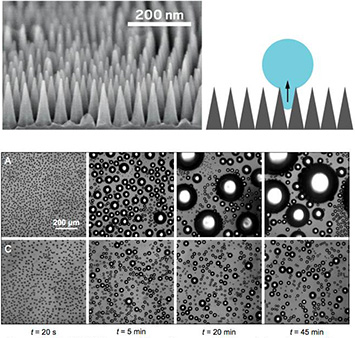Self-Assembled Nanotextures are Impervious to Fog
April 26, 2017
What is the scientific achievement?
A team of CFN users and staff showed that self-assembled, conical-shaped nanotextures expel condensing water droplets with an extremely high efficiency, rendering surfaces impervious to fog and outperforming textures with different shapes and sizes.
Why does this achievement matter?
These results demonstrate the importance of both the texture’s characteristic feature size and shape on its antifogging ability.
What are the details?
 enlarge
enlarge
Top: (left) SEM image of self-assembled anti-fogging surface nanotexture. (right) Schematic of the anti-fogging mechanism. Bottom: High-resolution photographs of microscopic fog droplets condensing on (top row) a hydrophobic nanotexture, and (bottom row) an anti-fogging nanotexture. The anti-fogging nanotexture inhibit growth of the fog droplets.
CFN Capabilities:
These results demonstrate the importance of both the texture’s characteristic feature size and shape on its antifogging ability.
Publication Reference
T. Mouterde,1, 2 G. Lehoucq,3 S. Xavier,3 A. Checco,4 C. T. Black,5 A. Rahman,5 T. Midavaine,6 C. Clanet,1, 2 D. Quere,1, 2 Antifogging abilities of model nanotextures, Nature Materials, DOI:10.1038/nmat4868 (2017).
DOI:10.1038/nmat4868
BNL press release: Water-Repellent Nanotextures Found to Have Excellent Anti-Fogging Abilities
Chemical & Engineering News: Nanostructures lift the fog
YouTube Video: Fighting fog with nanotechnology
Science Daily: Water-repellent nanotextures found to have excellent anti-fogging abilities
Physics World: Insects inspire water-repellent material
Acknowledgement of Support
We thank Direction Générale de l'Armement (DGA) for contributing to the financial support, Rose-Marie Sauvage for her constant interest, and Thales for cofunding this project. Research carried at Brookhaven National Laboratory is supported by the U.S. Department of Energy, Office of Basic Energy Sciences, under Contract No. DE-SC0012704 and used resources of the Center for Functional Nanomaterials, which is a U.S. DOE Office of Science Facility. We finally thank Mane-Si-Laure Lee and Brigitte Loiseaux from Thales Research and Technology for many fruitful discussions.
2017-12216 | INT/EXT | Newsroom









